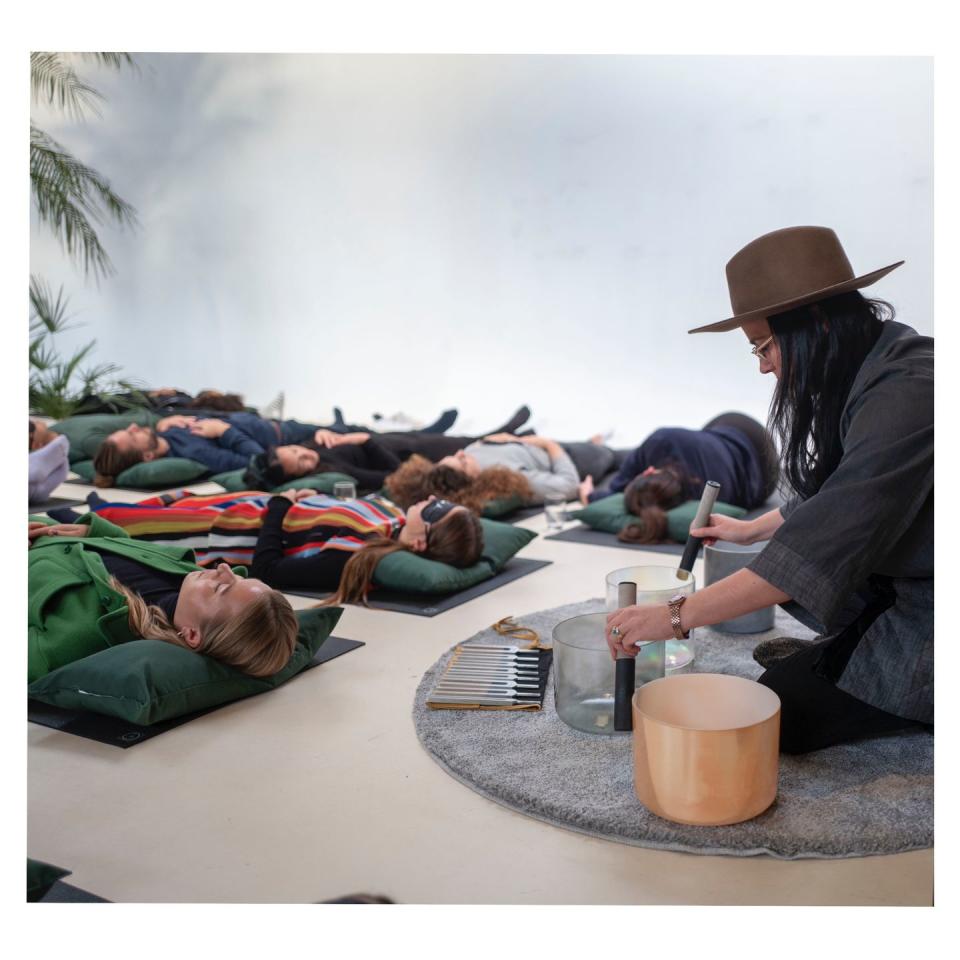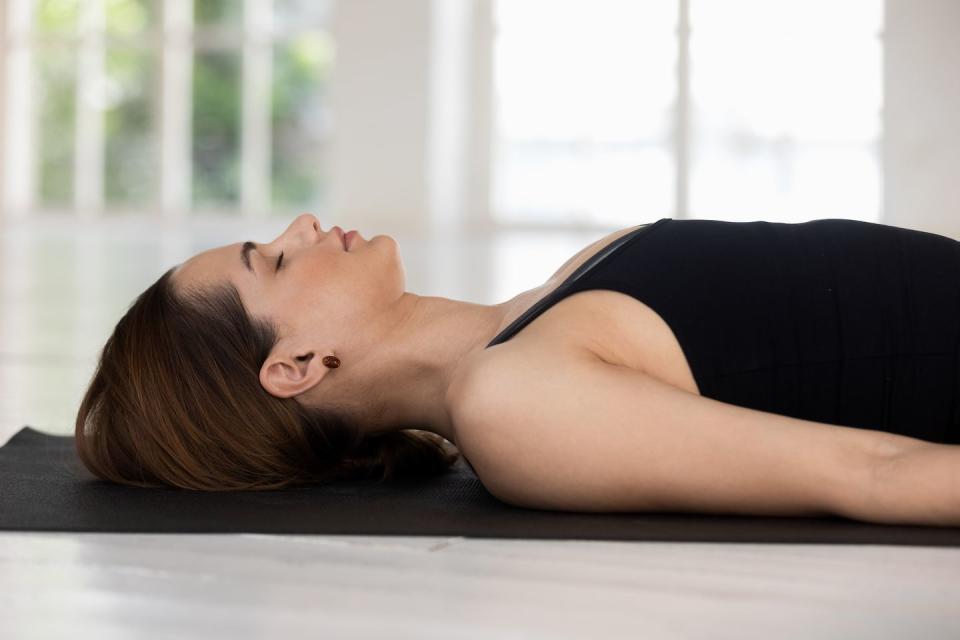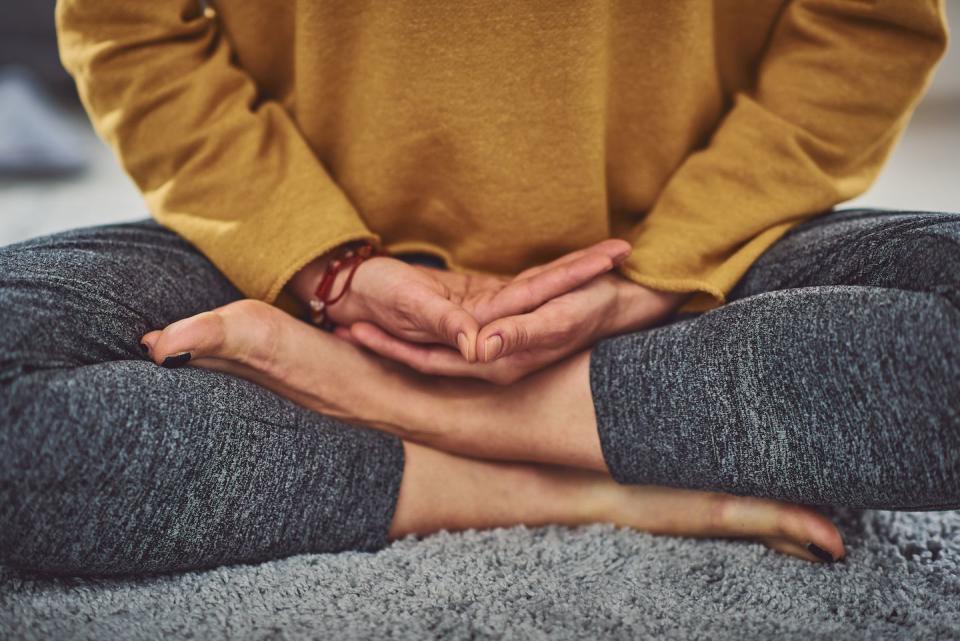Your Go-To Guide To Meditation If You Have The Attention Span Of A Goldfish

Meditation might be an ancient practice but its benefits for reducing stress, improving mood, sleep and focus transcend centuries.
For millennia, people have been meditating to connect and reflect on their life to find deeper meaning. It’s an intensely personal and spiritual experience that requires dedication and is practised by everyone from Oprah Winfrey and Jennifer Lopez, to Angelina Jolie and Eva Mendes.
‘By practicing meditation with regularity, you will be able to downshift into the body’s natural relaxation response, helping to lower blood pressure, and improve heart rate and breathing,' Sara Auster, one of New York’s top sound therapists and meditation teachers, tells ELLE UK.
But just how straightforward is practising meditation on a daily, if not weekly, basis? After all, if it was so simple to calm and refocus the mind, wouldn’t we all be doing it?

We spoke to several experts to find out everything you need to know about meditation, from what it is and its techniques, to breathing and body scanning.
What is meditation?
It’s unknown when exactly meditation came about, but the earliest documented mention involved Vedantism, a Hindu tradition in India, around 1500 BCE. The verb ‘to meditate’ originated in the 12th Century and comes from the Latin word ‘meditatum’ meaning ‘to ponder’.
The five major religions – Hinduism, Buddhism, Judaism, Christianity, and Islam all practice forms of meditation – but its widely practiced by non-believers, too.
Contrary to popular belief, meditation is more than just sitting with your legs crossed and closing your eyes in order to ‘find yourself’.
According to the meditation app Headspace, meditation is has nothing to do with someone trying to become a different, new or better person. ‘It’s about training in awareness and getting a healthy sense of perspective,’ it explains. Meditation isn’t about preventing your thoughts from wandering or 'disappearing', rather observing them without judgment.
Sarah Romotsky, Director of Healthcare Partnerships at Headspace, tells us: ‘You can practice meditation anywhere; there is no set location, or any equipment needed, and you don’t need to necessarily be lying down or sitting on the floor.'
Why is meditation positive for the body and mind?
There’s often confusion about mindfulness - the ability to be present, free from distraction, with an open mind and a kind heart - and meditation.
‘Living more mindfully, by focusing your attention on the present moment without judgement, is a wonderful way to ease stress and anxiety, while creating a sense of peace and ease,’ explains Romotsky. ‘And then meditation is the more formalised practice of training in mindfulness.’
To better understand this, Auster advises experimenting with a sound bath – whereby participants 'bathe' in sound waves – for a ‘deeply-immersive, full-body listening experience’ that nurtures both mind and body.
‘A sound bath can be helpful for anyone who wants to access the benefits of meditation but may be intimidated by the so-called “rules” of meditation. Instead of a meditative practice that requires you to sit up straight or have a point of focus, recite a mantra or count your breaths, to fully participate in a sound bath you simply need to show up and listen.'

The meditation expert knows that finding space to listen in a world that’s ‘over-stimulated and noisy’ can be a challenge and notes that even the best listeners ‘can struggle to quiet the mind and be fully present’.
‘But when we tune out from constant status updates, non-stop news cycles and instantaneous access to every song/movie/show ever made, we can clear mental space to listen deeply and truly rest,’ she adds.
What are the stages of meditation?
There’s no prescriptive way to meditate. As with many practises, the way you meditate might be different to the way a friend, teacher or celebrity goes about it.
Here’s Auster's advice for how to meditate at home with a recording:
Get comfortable, either seated or lying down. Choose a position that you can be still in for about 20 minutes.
Close your eyes (or cover them with an eye mask) and take three deep breaths. Inhale for four counts through the nose and exhale through the mouth. Then return to the natural breath.
Turn your attention to your listening. Focus on the sound and the contrast it leaves in the room after it fades away.
Let the sounds you hear anchor you in the present moment. Try not to get caught up in judging what you hear or analysing the sounds; just listen, observe, and experience them. If you become restless or other thoughts come in, acknowledge and allow them but do not react to them. Stick with this for the length of the recording.

Become aware of the space around you. Consciously become aware of the space in front, behind, and to the sides—even above and below. Allow yourself to feel as if your mind is expanding into the space surrounding, even expanding outside of the room.
When the recording is complete, allow yourself to sit in silence for one to two minutes.
Gently make small movements through your body, and slowly open your eyes. Observe how your awareness has shifted from the beginning of the practice.
How can you find more time for meditation?
We know that finding time to read a book is often hard enough, let alone carving out a moment in the diary for 15 minutes of meditation. But in order to be truly present in life and reap its benefits in a calm and fulfilled way we need to take time to be recognise our thoughts, feelings and environment.
‘There is a Zen proverb that goes something like this: “You should sit in meditation for 20 minutes each day, unless you are too busy; then you should sit for an hour”,’ Auster notes. ‘If there are so many crazy things going on in your life, then all the more reason to stop for a few minutes.

‘Many people say they actually get more done and feel more productive after meditation. That’s because meditation helps improve focus and lowers stress. If 20 minutes a day feel challenging, start with two or three minutes and build up so you don’t get discouraged and skip it altogether. Something is always better than nothing.’
So, how do you go about meditating while balance a hectic social and work life?
Romotsky suggests starting small, noting: ‘Setting aside just three to 10 minutes each day to meditate is all you really need to feel the benefits and to help keep you in a calm and present mindset.
‘We find that people who meditate in the morning or integrate it into a consistent routine, same time, same place, are most likely to maintain their practice over time.'
Auster believes in thinking about the ‘3 Es’ when beginning a meditation practice.
Effort – ‘The hardest part is showing up, making time, making it a priority. (ie: the hardest part of a workout is getting to the gym).’
Ease – ‘Don’t try so hard. You don’t need a special outfit or meditation cushion or even a special app. Just set a timer on your phone for one minute and focus on your breathing or the sounds in your environment, or play one of my one-minute Sound Baths. Soon enough you’ll realise how much you enjoy having this quiet time for yourself. Then you can extend to 2, 5 or even 20 or 30 minutes (we always make time for things we like to do).’
Every day – ‘Repetition creates recognition, and routine becomes ritual. Pick a time of day that works for you and stick with it. If you have two minutes to brush your teeth twice a day then I’m sure you have time to meditate.’
‘Being able to access a moment of stillness internally when everything is rapidly swirling around outside of you (or perhaps also inside) is like a superpower,’ she adds.
What are the forms of meditation?
There are hundreds of types of meditation practice, which can depend on traditions, cultures, spiritual disciplines, and religions.

Fortunately, as there are many definitions and methods of meditation, there is no ‘right’ or ‘wrong’ way to meditate. The main types include: mindfulness, spiritual, focused, movement, mantra and transcendental. Find out more about which meditation technique suits you here.
‘Most calming meditation practices involve focusing on a particular object — your breath, a mantra, a visualisation, a physical object, even physical sensations within your body — and returning to that object whenever you get distracted or notice your mind starting to wander,’ explains the Headpsace app.

You can mediate on your own in silence, with a meditation app like Headsapce or Calm on the move, with music or with friends. As long as you’re focusing on your surroundings, feelings, sensations and thoughts then you’re good to go.
‘I find meditation in sitting on the floor with the kids colouring for an hour, or going on the trampoline,’ Angelina Jolie previously told Stylist magazine. ‘You do what you love, that makes you happy, and that gives you your meditation.’
How can you make your practice more comfortable?
It’s totally fine for your mind to wander slightly during meditation. In fact, that’s part and parcel of the practice and helps you notice other sensations in the body, your surroundings and thoughts you hadn’t paid much attention to previously.
‘Most first-time meditators find it strange and sometimes unnatural to sit in silence for a couple of minutes and be with their innermost thoughts and feelings,’ says Romotsky. ‘To sit and do nothing are the very things that the mind tends to resist.’
However, many people who attempt meditation panic that a wandering mind or feeling fidgety suggests they’ve somehow failing which couldn’t be further from the truth.

‘Meditation is about setting time aside to guide your mind. It’s a peaceful yet active process,’ adds Auster. ‘You’re not sitting back with a blank mind; instead you’re softly moving your mind toward more awareness, consciousness, and choice.’
She advises guiding your attention is a way to calm the mind, not silence it. ‘Each time you try, you will get better at it. There is a reason we call it a “practice.” It only works if you do it (again and again and again).’
If you feel uncomfortable practising meditation, Romotsky advises asking yourself where feelings of discomfort are coming from; does it reflect feelings in the mind or external influences?
‘A lot of the time, these feelings may be caused by resistance and fighting against these might cause more agitation. By allowing these emotions to escape the body during meditation, both the mind and the body can settle down quite quickly,’ she says.
When it comes to Sound Baths, in particular, Auster notes that being comfortable is important as chances are if you’re in pain or distressed you won’t want to practise again.
‘It is not necessary to sit cross legged and perfectly straight,’ she notes. ‘Try sitting in a chair or on the couch or even lying down.
‘When you’re lying down, try supporting the body in different ways. Use pillows, blankets or towels to support your lower back, knees, head, neck and arms. You may even want to weight the body with a blanket across the midsection, to cultivate a grounding sensation.’

She also suggests creating ‘a peaceful corner of a room’ where you live and decorating it with ‘beautiful or meaningful objects there to make the space feel special’.
If you’re someone who can’t sit still, Romotsky suggests mindfulness on the move, taking in all the sights, sounds and smells – particularly those you would not normally notice.
She says: ‘Mindful walking can help you to step away, reset, refresh, and be present in the moment, preventing your mind becoming distracted from stressful and unwanted thoughts.’ Check out Headspace’s Mindful Walking exercises here.
How important is breathing in meditation?
Inhaling and exhaling is a pretty essential component for survival, but it's also key in helping calm and prepare the body and mind for meditation.
Auster quotes Paula Watkins, PhD, a clinical psychologist and meditation expert, who says that 'the process of breathing sits directly at the interface of our voluntary nervous system (aspects of our physiology under our conscious control) and our autonomic nervous system (aspects generally not under conscious control)'.

‘It’s a direct path for us to communicate quickly to the brain via what we do with our body. It also offers a direct link for balancing the sympathetic (fight-or-flight) and parasympathetic (rest-and-relax) branches of the nervous system,' she adds.
Auster notes that some breathing exercises are thought ‘to bring balance emotionally, mentally, and physically. Science is only beginning to explore how and why this is happening’.
To mindfully breathe, Romotsky suggests finding a comfortable upright position.
'As you inhale, your diaphragm muscle contracts downwards and as you exhale, the muscle relaxes upward; having the space in your physical body to expand is helpful in order to reap the benefits,' she says.
'If you find yourself becoming stressed, a couple of deep diaphragm breaths – breathing shallowly (also known as chest breathing) – can help to reset your breath and help aid relaxation.'
A post shared by Headspace (@headspace) on Jun 29, 2020 at 10:05pm PDT
Do you need to wear certain clothes to meditate?
‘There is no dress code to get into the meditation club, no bouncer outside the door to enlightenment turning people away because of their wardrobe,’ jokes Auster, who says that many people she works with wear suits, ties and jeans for the practice.
‘If you happen to love flowy pants, colourful leggings, mala beads, patchouli oil, and crystals that’s great, but these items aren’t a required entry point to starting a meditation practice,’ she adds.
A post shared by Sara Auster (@saraauster) on Jul 13, 2020 at 6:15am PDT
What are the best ways to body scan?
If you've ever noticed your mind doing one thing and your body reacting in a completely different manner, you're unconsciously body scanning.
'A body scan is when you mentally scan yourself from head to toe, being aware of every part of your body as you go down and flagging any areas of aches, pain, tension, or general discomfort,' explains Romotsky.
Scanning helps us increase out awareness to the patterns and make them one.
She adds: 'The Headspace Body Scan meditation recommends sitting down in a comfortable position, taking a deep breath to begin and then closing your eyes before scanning down from the top of your head to the tips of your toes, noticing any particular areas of tension or perhaps calm.'
Which celebrities meditate?
There are several A-list celebrities who have advocated for the benefits of meditation over the years.
Celebrities who meditate include Hugh Jackman, Paul McCartney, Tina Turner, Sheryl Crow and Halle Berry.
In 1999, J-Lo opened up to Winfrey about using meditation to stay grounded while living in hotels in New York. ‘Meditation helped me connect to who I am,’ she said. ‘The way I do that is by centring myself and taking time for myself to connect to me.’
Years later, Winfrey wrote about her own love of meditation, writing on her website: ‘I'm a big proponent of formal meditation—for the discipline, joy, and calm it brings—I'm moving into an even greater phase of being fully present all the time.
‘It's a heightened state of being that lets whatever you're doing be your best life, from moment to astonishing moment.’
In 2016, Katy Perry opened up about her love of transcendental meditation which she began to practise five years prior.
Describing it the technique as ‘a great workout for your mind without working out’, she said: ‘I’m on a plane more than I am on ground. This tool helps me find moments of peace – because I don’t have a whole lot of time – that extend my day so I can live my fullest capacity. It gives me two days in one day!’
Like this article? Sign up to our newsletter to get more articles like this delivered straight to your inbox.
In need of more inspiration, thoughtful journalism and at-home beauty tips? Subscribe to ELLE's print magazine now and pay just £6 for 6 issues. SUBSCRIBE HERE
You Might Also Like

